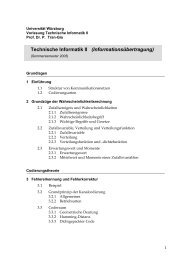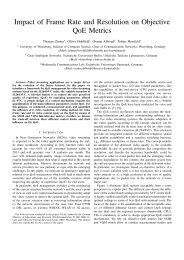Measurement and Analysis of Skype VoIP Traffic in 3G UMTS Systems
Measurement and Analysis of Skype VoIP Traffic in 3G UMTS Systems
Measurement and Analysis of Skype VoIP Traffic in 3G UMTS Systems
Create successful ePaper yourself
Turn your PDF publications into a flip-book with our unique Google optimized e-Paper software.
throughput [kbps]403530252015p loss= 10%10p loss= 50%5senderp loss= 70%receiver00 100 200 300 400 500time [s]Figure 3: Us<strong>in</strong>g dummynet, <strong>Skype</strong> reacts on packet loss by <strong>in</strong>creas<strong>in</strong>g the sender throughputdummynet scenario, the r<strong>and</strong>om variable L dummy follows a geometric distribution shifted byone: L dummy ∼ GEOM 1 (q) with parameter q = µ−1µ<strong>and</strong> a mean measured distance µ. Thenumber <strong>of</strong> consecutive packets without any packet loss is denoted as K. It holds: K = L − 1.Figure 4 compares the <strong>in</strong>ter packet loss distance for the dummynet <strong>and</strong> the traffic shap<strong>in</strong>grouter scenario. In the dummynet scenario, the packet loss probability was set to 50 percent. Inthe traffic shap<strong>in</strong>g router scenario, the b<strong>and</strong>width on the l<strong>in</strong>k was restricted to 16 kbps whichresults <strong>in</strong> a packet loss ratio <strong>of</strong> 48 percent. The dummynet s<strong>of</strong>tware leads to a geometric distributionwith q = 0.5 <strong>in</strong> Figure 4(a). This means each packet gets lost with propability q. Thetraffic shap<strong>in</strong>g router, however, leads to a completely different behaviour. Packets do not get lost<strong>in</strong>dependent <strong>of</strong> each other, but <strong>in</strong> bursts, which can be seen from Figure 4(b). Due to the nature0.70.60.5measuredGEOM 1(q)10.8measuredprobability0.40.3probability0.60.40.20.10.200 5 10<strong>in</strong>ter packet loss distance(a) Dummynet01 2 3 4 5 6 7 8 9 10 11 12<strong>in</strong>ter packet loss distance(b) <strong>Traffic</strong> shap<strong>in</strong>g routerFigure 4: Distance between two consecutive packet losses4
















